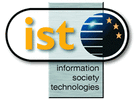| Name | Last modified | Size | Description | |
|---|---|---|---|---|
| Parent Directory | - | |||
| README.html | 2004-03-01 01:51 | 7.5K | ||
| actions.sh | 2004-03-01 00:40 | 261 | ||
| cancel.sh | 2004-06-12 16:11 | 165 | ||
| done.sh | 2004-03-01 00:41 | 165 | ||
| dropDone.n3 | 2004-03-01 00:41 | 577 | ||
| ra2cal3.n3 | 2004-03-01 14:33 | 1.3K | ||
This is currently a very rough draft for implementing some ideas. It is intended to show how Semantic Web technology applied to the W3C site actually makes our life easier. In particular it is meant to highlight that some really neat things were very easy, by building on other Semantic Web stuff that has been done.
This is version $Id: README.html,v 1.14 2004/03/01 01:51:07 charles Exp $ and the code it describes is still very scrappy (missing basic things like version identifiers comments, ...)
Please do not rely on this code being stable, as almost everything in it is changing. This is made available to allow others to comment, or to see what is being done.
Please send comments to the RDF Calendar task force. Note that they will be publicly archived.
RRSAgent is an irc bot that follows meetings in IRC, and among other things can record action items. It produces a log of the discussion, and an RDF version of the action items.
The original idea was to collect action items from a number of discussions in the same group, mark some as done, and be able to generate a list of the ones that are still current.
It is useful to put those into icalendar format, as "to do" items - this would allow people to track them in their favourite calendar systems.
To run this stuff, you need cwm (or a similar n3 rules capable RDF parser), and a Unix shell. To do the conversion to icalendar you will also need toIcal.py and whatever it requires.
You can take any number of RRSAgent action item lists, and generate a combined list (assuming you have the command cwm aliased somehow to run cwm.py):
cwm --rdf http://www.w3.org/2004/01/05-tagmem-actions.rdf http://www.w3.org/2004/01/16-Annotea-actions.rdf(actually this mixes items from 2 groups, and isn't very interesting really).
You can also mark an action item as having been done.
sh done.sh http://www.w3.org/2004/01/05-tagmem-actions.rdf#1or as being cancelled:
sh cancel.sh http://www.w3.org/2004/01/05-tagmem-actions.rdf#1At the moment this approach is pretty ugly - it just drops a line of code at the end of a magic file, finished.n3.
Using the magic file finished.n3, you can collect a set of action items and list those that are current:
sh actions.sh http://www.w3.org/2004/01/05-tagmem-actions.rdf http://www.w3.org/2004/01/16-Annotea-actions.rdf(actions.sh now uses the unix commands which and locate to find python and cwm.py)
This dumps a lot of stuff onto stdout, which is an rdf list of action items, with the completed ones filtered out, in a format that toIcal.py can convert into .ics files that @@almost work in Apple's ical.
With a bit of manipulation you can get the items in Apple's iCal. If you add
<http://www.w3.org/2004/01/05-tagmem-actions.rdf#1> :dtstart [ :dateTime "2004-01-29T14:31:21Z" ] .(changing the URI for each item in the output, and the actual date as you like) and run toIcal.py over the results, it will produce things that iCal accepts as valid "to do" items. @@Are these dtstart or dtstamp? Anyway, can do, just need to test which one makes the software happy. (They are both optional according to the spec).
quite a lot :(
This work is sponsored by the SWAD-Europe project. 
This work would not have been possible without invaluable help and suggestions from Dan Connolly in particular, and from many others including
It builds on many pieces of work - most directly on the work of the RDF Calendar task force, travel information management work done by Dan Connolly and Jim Ley, IRC bots built by Ralph Swick, Dave Beckett and others, ...